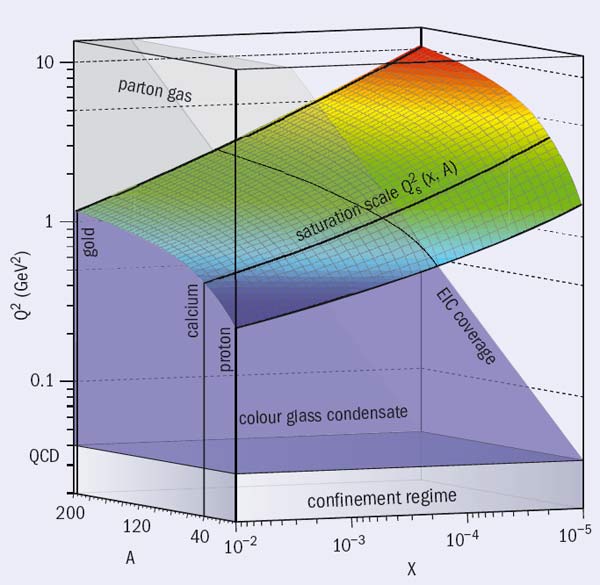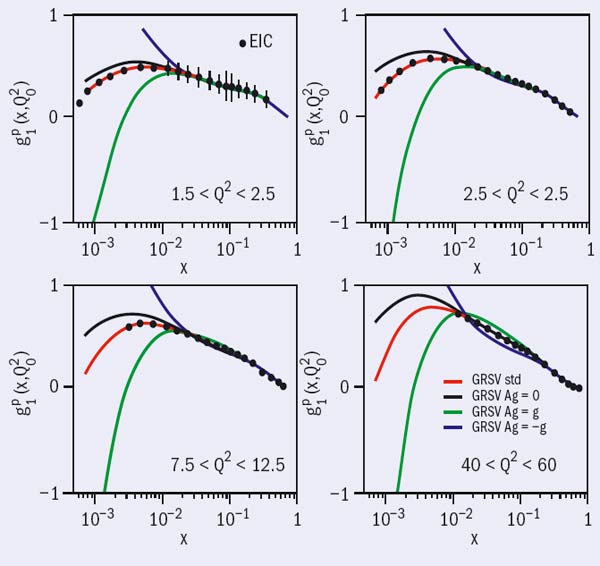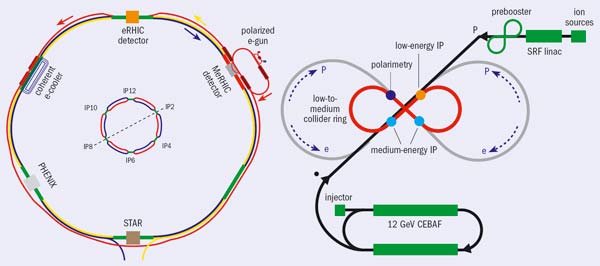Plans for a high-luminosity, high-energy, polarized electron–ion collider.

Understanding the fundamental structure of matter requires determining how the quarks and gluons of QCD are assembled to form hadrons – the family of strongly interacting particles that includes protons and neutrons, which in turn form atomic nuclei and hence all luminous matter in the universe. Leptons have proved to be an incisive probe of hadron structure because their electroweak interaction with the hadronic constituents is well understood. Experiments to probe the quarks and gluons within the hadrons require high-intensity, high-energy lepton beams incident on nucleons; and if the leptons and nucleons are polarized, then measurements of spin-dependent observables are possible, so casting light on the spin structure of the hadrons.
Current experiments with polarized leptons focus predominantly on the valence quarks. To learn more about the sea quarks and gluons, physicists who study hadron structure have identified a high-luminosity, polarized electron–ion collider (EIC) as the next-generation experimental facility for exploring the fundamental structure of matter. The proposed EIC would be unique in that it would be the first to collide highly energetic electrons and nuclei, and be the first to collide high-energy beams of polarized electrons on beams of polarized protons and, possibly, a few other polarized light nuclei. It would be designed to achieve at least 100 times the integrated luminosity of the world’s first electron–proton collider, HERA, over a comparable operating period.
The EIC would offer unprecedented opportunities to study, with precision, the role of gluons in the fundamental structure of matter. Without gluons, matter as we know it would not exist. Gluons collectively provide a binding force that acts on a quark’s colour charge but – unlike the photons of QED – they also possess a colour charge, so can self-interact. These self-interactions mean that gluons are the dominant constituents of matter, making QCD equations extremely difficult to solve analytically. Recent theoretical breakthroughs indicate that analytic solutions may be possible for systems in which gluons collectively behave like a very strong classical field – the so-called “colour glass condensate (CGC)”. This state has weak colour coupling despite the high gluon density and is characterized by a “saturation” momentum scale, Qs, which is related to the gluon density. QCD also predicts a universal saturation scale where all nuclei, baryons and mesons have a component of their wave function with identical behaviour, implying that they all evolve into a unique form of hadronic matter.

The discovery of CGC would represent a major breakthrough in the understanding of the role of gluons in QCD under extreme conditions. To probe the CGC optimally requires collisions of high-energy electrons and heavy ions (with large atomic number, A) resulting in large centre-of-mass energy (i.e. small gluon momentum fraction, x). The EIC would allow exploration of this novel regime of QCD because the use of heavy nuclei in experiments amplifies the gluon densities significantly over electron–proton collisions at comparable energies. Figure 1 shows the dependence of the saturation scale Qs2 on x and A and indicates the region that would be accessible to the EIC.
The ability to collide spin-polarized proton and light-ion beams with polarized electrons (and possibly also positrons) would give the EIC unprecedented access to the spatial and spin structure of protons and neutrons in the gluon-dominated region, complementary to the existing polarized-proton collider, RHIC, at Brookhaven National Laboratory (BNL). Figure 2 illustrates how the EIC would extend greatly the kinematic reach and precision of polarized deep-inelastic measurements compared with present (and past) polarized fixed-target experiments at SLAC, CERN, DESY and Jefferson Lab.
The polarizations measured so far for the sea quarks and gluons are consistent with zero, albeit with large uncertainties. Given that the quarks contribute only about 30% to the spin of the proton, this is surprising. The EIC is ideally suited to resolve this puzzle: it would measure with precision the contribution of the quarks and gluons to the nucleon’s spin deep in the non-valence region (figure 3) and also study their transverse position and momentum distributions, which are thought to be associated with the partonic orbital angular momentum. This could provide tomographic images of the nucleon’s internal landscape beyond the valence-quark region, which will be probed with the 11 GeV electron beam at Jefferson Lab’s Continuous Electron Beam Accelerator Facility (CEBAF). Both measurements are essential to understand the constitution of nucleon spin.

Excited by these prospects, physicists came together in 2006 to form the Electron–Ion Collider Collaboration (EICC) to promote the consideration of such a machine in the US. They have developed the scientific case for an EIC with a centre-of-mass energy in the 30–100 GeV range and luminosity of about 1033 cm–2s–1. The flagship US nuclear-physics laboratories BNL and Jefferson Lab have developed preliminary conceptual designs based on their existing facilities, namely RHIC and CEBAF, respectively. These early concepts have since evolved into significantly more advanced designs (figure 4). Options include the possibilities of realizing electron–nucleus and polarized electron–proton collisions at lower energies and at lower initial costs. Considerable effort is underway to achieve the highest luminosities – up to 1035 cm–2s–1 – which would maximize the access to the physics and help in make the strongest possible case for the EIC.
Future prospects
The scientific argument for the EIC has been discussed in the US nuclear-physics community since its first formal presentation at the Nuclear Science Advisory Committee’s (NSAC) 2002 long-range planning exercise and most recently in a similar exercise held in 2007. The result is that the EIC has been embraced as embodying the vision for reaching the next QCD frontier. The community recognizes that the EIC would provide unique capabilities for the study of QCD well beyond those available at existing facilities worldwide and would be complementary to those planned for the next generation of accelerators in Europe and Asia. NSAC has recommended that resources be allocated to develop the necessary accelerator and detector technology for the EIC.

Two separate proposals for EICs are being considered in Europe. In the LHeC the existing LHC hadron beam would collide with a 70–140 GeV electron beam. The resulting collisions with the 7 TeV proton beam would allow a centre-of-mass energy of about 1.4 TeV. Such a high energy would enable the study of gluons and their collective behaviour at their highest possible densities (lowest possible x). It would also allow exploration of possible physics beyond the Standard Model with a lepton probe at very high Q2. The other European EIC proposal is motivated by the spin structure of the nucleon. The European Nucleon Collider (ENC) would make use of the High-Energy Storage Ring (HESR) and the PANDA detector at the proposed Facility for Antiproton and Ion Research (FAIR) at GSI. The centre-of-mass energy proposed for this facility is around 14 GeV, which lies between the fixed-target experiments HERMES at DESY and COMPASS at CERN. The primary goal of ENC is to explore the 3D structure of the nucleons, including the transverse-momentum distributions and generalized parton distributions for the quarks.
Since 2007 the EICC has met approximately every six months at Stony Brook University in New York, Hampton University in Virginia, Lawrence Berkeley National Laboratory and, most recently, at GSI. The next meeting is scheduled to take place at Stony Brook University in January 2010. The directors of BNL and Jefferson Lab have formed an EIC International Advisory Committee (EICAC) to help prepare the case for the project in the US. The EICAC met for the first time in Washington DC in February 2009 and will meet again in November at Jefferson Lab. The EICC is working towards the consideration of the EIC by NSAC as a priority for new construction in its next long-range plan anticipated in 2012 or 2013.
• Detailed information on EICC and EICAC meetings is available at http://web.mit.edu/eicc.







